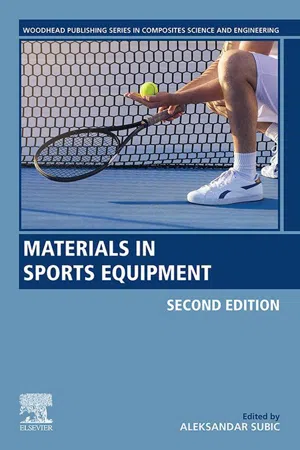
- 604 pages
- English
- ePUB (mobile friendly)
- Available on iOS & Android
Materials in Sports Equipment
About This Book
Materials in Sports Equipment, Second Edition, provides a detailed review on the design and performance of materials in sports apparel, equipment and surfaces in a broad range of sporting applications. Chapters cover materials modeling, non-destructive testing, design issues for sports apparel, skull and mouth protection, and new chapters on artificial sport surfaces, anthropometric design customization, and 3D printing in sports equipment. In addition, the book covers sports-specific design and material choices in a range of key sports, from baseball, rowing, and archery, to ice hockey, snowboarding, and fishing.
Users will find a valuable resource that explicitly links materials, engineering and design principles directly to sports applications, thus making it an essential resource to materials scientists, engineers, sports equipment designers and sports manufacturers developing products in this evolving field.
- Provides both updated and new chapters on recent developments in the design and performance of advanced materials in a number of sports applications
- Discusses varying aspects, such as the modeling of materials behavior and non-destructive testing
- Analyzes the aerodynamic properties of materials and the design of sports apparel and smart materials
- Explores new topics on athletic equipment, such as 3D printing and anthropometric design customization and on artificial sports surfaces
Frequently asked questions
Information
Modeling of Materials for Sports Equipment
Abstract
Keywords
1.1 Introduction
- 1. Atomistic or ab initio modeling (Wahn & Neugebauer, 2006) based on interatomic potentials which can be used to design specific localized properties, such as doping of semiconductor devices.
- 2. Analytical models: these operate at the micron to millimeter scale and involve thermodynamics and kinetics for structural changes as well as dislocation motion relating to strength and fracture. They are used in designing material compositions and microstructures to achieve properties over a limited portion of the structure (Ghosh, Van de Walke, Asta, & Olson, 2002; Robson, 2004). This could be viewed as the ideal or target composition and microstructure for the processed component.
- 3. Process modeling (Grong, 1994): these models often involve numerical methods, such as finite element (FE) and computational fluid dynamics in order to determine thermomechanical and fluid flow conditions throughout complete components such as shaped castings or forgings. They give structures and properties which are more average, that is, they do not have the fine-scale resolution of structure possible in (2), but do give variations across full components and can predict defects such as porosity in castings (Lee, Chirazi, Atwood, & Wang, 2004).
- 4. Continuum mechanics: these models (also often numerical) are used to define the properties, for example, strength and stiffness, required at different positions throughout the component.
1.2 Properties of Metallic Alloys
| Alloy | Density, ρ (g/cm3) | Young’s modulus, E (GPa) | Yield stress, σy (MPa) | Tensile strength, UTS (MPa) | Ductility (%) |
|---|---|---|---|---|---|
| C–Mn (mild) steel | 7.85 | 210 | 210–350 | 400–500 | 15–35 |
| High-strength steel, e.g., 4340 | 7.85 | 207 | 860–1620 | 1280–1760 | 12 |
| 316 stainless steel | 7.85 | 195 | 205–310 | 515–620 | 30–40 |
| Cu–Be | 8.25 | 128 | 200–1200 | 450–1300 | 4–60 |
| Al–Cu | 2.77 | 73 | 75–345 | 185–485 | 18–20 |
| Al–Mg | 2.77 | 70 | 130–192 | 225–275 | 7–22 |
| Mg–Ti | 1.78 | 45 | 200–220 | 260–290 | 15 |
| Ti–3Al–2.5V | 4.50 | 105–110 | 750 | 790 | 16 |
| Ti–6Al–4V | 4.43 | 110–125 | 830–1100 | 900–1170 | 10–14 |
| Ti–15V–3Al–3Si–3Cr (β-titanium) | 4.71 | 85–120 | 800–1270 | 810–1380 | 7–16 |
Table of contents
- Cover image
- Title page
- Table of Contents
- Copyright
- List of Contributors
- Part I: General Issues
- Part II: Specific Sports
- Index
